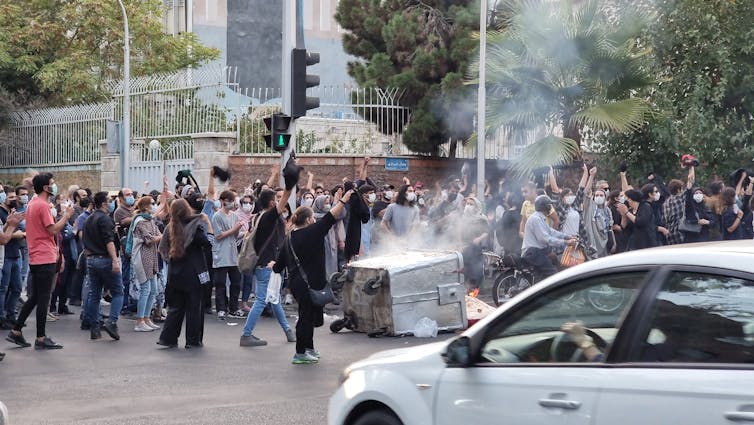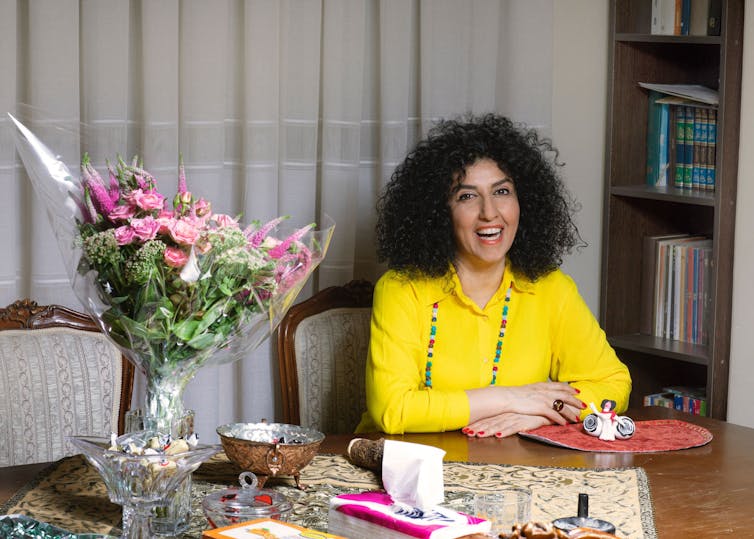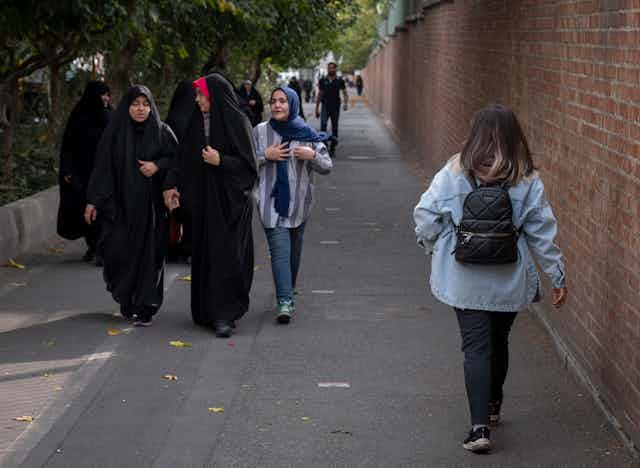Large-scale protests that erupted in 2022 across Iran, centering on women’s rights, captured the world’s attention.
Iranians peacefully protested in the streets of places ranging from Tehran to small towns across the country, chanting, “Woman, life, freedom.” The protests reflected many Iranians’ growing frustration with the political regime in power since 1979 – and its ongoing violation of citizens’ basic rights, especially those of women and other historically marginalized groups.
While the latest wave of street protests dwindled by the first few months of 2023, nonviolent protests for freedom, democracy and equality have a long history in Iran and continue today.
The Nobel Peace Prize committee granted its 2023 prize to Narges Mohammadi, a prominent and currently imprisoned women’s rights advocate in Iran. This recognized popular resistance to Iran’s authoritarian regime.
As a scholar of women’s rights in Muslim cultures, I have documented women’s political activism in Iran and other Middle Eastern countries. My research shows that even when women are not demonstrating en masse in the streets, they consistently fight against gender discrimination, often at their own peril.

Understanding women’s rights in Iran
In 1979, Iran underwent a major political revolution after protesters toppled the country’s long-standing secular monarchy.
In its place, conservative clerics established an Islamic government. One key feature of the new government was greatly restricting women’s rights, such as forcing all women to appear in public with a proper hijab, or a modest form of dress that covers their hair and body, while only their face and hands are uncovered. Although many Iranian women protested mandatory hijab, by 1981 the new Iranian government began to enforce it.
Today, women and teen girls in Iran who appear in public with improper hijab, or showing parts of their hair or body, risk punishment, ranging from monetary fines to imprisonment.
Iranian women have been campaigning against such discriminatory laws by publicly demanding their rights from the regime throughout the years.
Women’s protests resulted in a few legal changes, like the government recognizing women’s rights to get custody of their children in some circumstances, or establishing some grounds for women to ask for a divorce.
But women and girls continue to have few rights compared with men and routinely experience gender discrimination in Iran.
The 2022 Iran protests
The latest round of women-led protests in Iran erupted after police killed a 22-year-old Kurdish-Iranian woman named Mahsa Jhina Amini in September 2022. Police officers beat her while she was in custody for allegedly violating the mandatory hijab laws.
For months, women led the vast majority of the protests across Iran, risking their lives and freedom.
Within the first five months of the protests, police imprisoned nearly 20,000 activists and protesters. While the majority of the protesters were later pardoned and released, an unknown number still remain behind bars.
The protests also resulted in police killing at least 500 individuals, many of them children.
Shifts in Iranian protests
While these mass protests have died down, political activism in the name of equality and freedom in Iran remains vibrant and active – it has just taken on different forms.
One new dimension to Iran’s women rights movement is that widely recognized, imprisoned female activists continue to leak statements and voice recordings, decrying their conditions in prison and encouraging activists to keep up their work.
Discussions about women’s rights activism are also increasingly happening in private forums on Telegram, WhatsApp channels and other social media platforms.
Women also continue to quietly engage in civil disobedience – although this comes with its own risks.
One example is Iranian women simply not covering their hair when they appear in public. One 2023 report estimates that at least 20% of Iranian women defy Iran’s mandatory hijab laws.
In October 2023, Iran’s notorious morality police beat and killed 17-year-old Armita Geravand after she appeared unveiled on her way to school.
Other women are refusing to back down, despite Iran banning female students and faculty with improper hijab from entering university campuses or receiving their course credits or degrees.
One Tehran university faculty member described to me how she covered her hair, but not with a maghnaeh, the state-mandated form of hijab that drapes over hair and shoulders, tightening around the face.
“I cover my hair, but not with a maghnaeh, rather with a loose headscarf. I am determined to appear as so and to support my students. I am not alone in dressing this way,” this woman said.
Iranian authorities have been debating another controversial bill that would make punishments for women who defy the hijab laws more severe.
The new bill authorizes use of facial recognition and social media surveillance to identify and punish women who do not observe the hijab as mandated by the conservative authorities.

Women abroad support Iranian activism
Iranian women and human rights activists living abroad have also been active in organizing conferences, workshops and podcasts on supporting pro-democratic uprisings inside Iran.
As one Iranian women’s rights activist based in the United States recently explained, “The Iranian women’s rights movement currently benefits from dual forms of activism: one inside Iran and the other by the Iranian diaspora.”
Since the 2022 protests, women’s rights advocates inside and outside of the country have formed stronger networks.
These advocates have positioned women’s rights and gender equality as key demands for the future of Iran, as some feminists outlined in a recently published Iran Women’s Bill of Rights.
State backlash against protests
The Iranian regime, meanwhile, has tried to ward off any kind of dissent.
Just weeks prior to the one-year anniversary of Amini’s killing and planned memorial events, Iranian authorities preemptively arrested several women’s rights defenders in August 2023. The authorities appeared to fear new street protests.
The government has also pressured the families of killed protestors to refrain from holding any memorial services. The rationale is that such gatherings would lead to more protests.
These government crackdowns on women’s rights defenders and any potential protests show the strength and viability of the Iranian women’s rights movement.
As the previous decades of resistance demonstrate, women’s nonviolent activism for democracy and freedom will continue, despite state violence.

